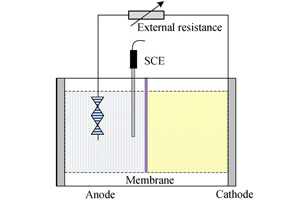研究不同污泥热水解时间下水解液特性及其对微生物燃料电池(MFC)产电的影响.水解时间由2 h增至96 h,水解液pH基本稳定于7.4 ~ 8.0;水解时间增加,其电导率逐渐提高至2.53 mS·cm-1,COD浓度和碱度也不断增加,水解液的缓冲能力不断得到提高.MFC最大功率密度达到25 W·m-3,COD去除率呈现先增后降,水解6 h时达到最大(47%);库仑效率在预水解4 h时达到最高(71%).阳极室pH下降可归因于NH4+、Na+、Ca2+、Mg2+等阳离子迁移,其中NH4+的迁移量最大.
Hydrolyzed sludge liquor was used as the substrate of microbial fuel cell. When the thermal treatment time increased from 2 h to 96 h, pH varied little between 7.4 and 8.0. When the treatment time increased, the conductivity, COD and alkaline condition increased to 2.53 mS·cm-1, 2520 mg·L-1 and 800 mg·L-1, respectively. Meanwhile, the power density increased to 25 W·m-3. The COD removal increased firstly, then decreased, and finally reached the maximum of 47% at the hydrolyzed time of 6 h. The maximal coulombic efficiency was 71% when the treatment time was 4 h. The transports of cations, including ammonium, sodium, calcium and magnesium ions, from anode chamber to cathode chamber would cause the decreases of pH in anode chamber, among which the ammonium mobility affected the most.


